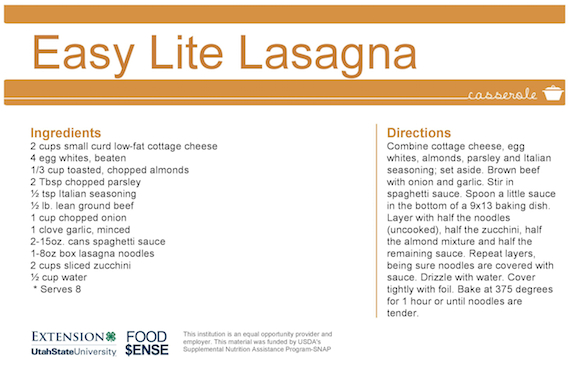
Follow these tips to save some extra money for the holidays!
Being a Frugal Foodie
Money spent on food is probably one of the biggest expenses in a household budget—perhaps even larger than a mortgage, depending on family size. Combine money spent on groceries with money spent eating out, and that number gets even larger.
Here are some tricks to save on food costs. And as a bonus, most money-saving tips will also help you eat healthier.
1. Make a meal plan and detailed shopping list. Together these will help you spend less time in the store, help you buy only what you need and help you avoid more frequent shopping trips. Remember to use foods in your cupboard and food storage as part of your meal plan instead of buying unnecessary duplicates.
2. Reduce the number of trips to the grocery store. Undoubtedly you’ve gone to the store to buy a gallon of milk and spent more than $10. Try to narrow store visits to once a week; if you shop more frequently than that, try twice a month. Buy as much milk, fruit, etc., as you need for that time, or try doing without an ingredient instead of making another trip to the store.
3. Shop when the stores are less crowded and NOT when you are hungry. Food originally not on your list suddenly appears in the cart when you’re hungry, which doesn’t save money. However, it is a good idea to make your meal plan when hungry because it’s easy to bring meal ideas to mind with a grumbling stomach.
4. Make food from scratch, or nearly from scratch. It is generally cheaper than buying pre-packaged foods. Buying a head of lettuce and a package of carrots and chopping it yourself will likely be cheaper and larger than buying a pre-packaged salad mix. But if you won’t chop the lettuce and carrots, it will be a waste of money. It’s almost always cheaper—and healthier—to choose more whole, fresh foods rather than boxed, bottled or frozen ready-to-eat options. Consider your options for saving money and compare that with your time and your family’s preferences. If you have time, options such as making homemade bread, tortillas and other bread products could save a lot of money over the long term.
5. Ditch the myth that healthy foods are more expensive. While some foods considered healthy are more expensive than less healthy foods, this is not always the case. For example, frozen salmon fillets could be considered healthier than sirloin steak, yet salmon is more expensive per pound. However, chicken is a lean meat, generally cheaper than sirloin steak and a healthier choice. Another example: for the price of a box of cereal (or cheaper), you could buy a large container of oatmeal, which has more servings than the box of cereal, provides 100 percent serving of whole grains, is naturally filled with fiber and nutrients and is free of added sugars.
6. Eliminate food waste. Healthy, fresh foods become expensive when they are allowed to spoil or age before they can be eaten. Carefully plan how you’ll use foods while they are fresh. List a few meals that use the same foods and refer to that when you have excess or when certain foods are on sale. Also try the “cook once, eat twice” idea where you make one large meal and repurpose it for a different meal the next day. Be sure to use the freshest foods first, then turn to frozen and canned foods. Another way to eliminate food waste and save on food is to carry leftovers or sack meals when on the go to avoid eating out.
7. Compare prices between generic and store brands. Generally foods higher or lower on the shelves will be cheaper than those at eye level. Also check unit pricing (most stores include this in the price tag on the shelf) and not just the price per container.
8. Use coupons carefully. If it is a product you usually buy and use, and the coupon will make the item cheaper than the generic brand, it is worth using. Check for online coupons that connect to your shopper’s card. Price matching can also be a great way to save money. Some stores require you to bring proof of the item price in another store, so be prepared.
9. Buy produce in season. The price of fresh produce can vary throughout the year, based on harvest season. Save money and vary eating habits by buying fresh produce in season. Watch for labeling of prices—most of the time, fresh produce is priced per pound, not per item. There could be a great difference between heads of cabbage that are .99 per pound versus .99 per head.
10. Don’t forget frozen and canned fruits and veggies. Most fruits and vegetables that are canned or frozen are processed quickly at their peak of ripeness and nutrition. Canned and frozen fruits and veggies without added sugars and salts are healthy options and can be less expensive than fresh options, especially for foods out of season or hard to find in your area. They also add an element of convenience since the chopping and/or peeling has been done, and they store well.
11. Since meat is costly, consider cheaper proteins including milk, eggs, peanut butter, Greek yogurt, cottage cheese, edamame and beans. Reduce the amount of meat used in recipes. If a stir-fry recipe calls for 2 pounds of chicken, try the recipe with 1 pound and add more veggies. Save the other pound for later. Or add more whole grains and vegetables to your diet.
12. Shop sales and stock up on foods you use often. Track prices of foods you use most, and when prices go down, buy more. Use food storage to plan your meals and rotate the food. This helps keep costs down and reduces food waste. Many grocery stores in Utah have seasonal case lot sales when prices are lower for many pantry-stable foods, such as canned goods, flour, sugar, rice, beans and oatmeal. There are also baking sales in late fall before the holidays.
13. Buy from the bulk section. Not all bulk items will be cheaper than pre-packaged foods, so compare prices carefully. However, buying bulk, scoop-it-out-yourself foods is an excellent way to get food you use frequently or to get small amounts of foods to try in new recipes, such as quinoa, whole grain pasta noodles, nuts, steel-cut oats and ground spices.
14. Grow a garden and use the produce in your meals and snacks. Visit livewellutah.org and click “recipes” for ideas on using produce easily grown or purchased in most parts of Utah.
15. Consider preserving garden produce for later use. Freezing, dehydrating and canning are all great ways to preserve food and have the potential to save you money and avoid food waste. Canning supplies can be expensive, but can be accumulated over time, and with the exception of canning lids, they can be used repeatedly. For safe, scientifically tested canning and preserving information, go to extension.usu.edu/foodpreservation or contact your local Extension office. For classes near you that will give you more healthy, eating-on-a-budget tips, visit https://extension.usu.edu/foodsense/htm/calendar.
This article was written by Melanie Jewkes, Utah State University Extension associate professor, Salt Lake County
References
extension.usu.edu














